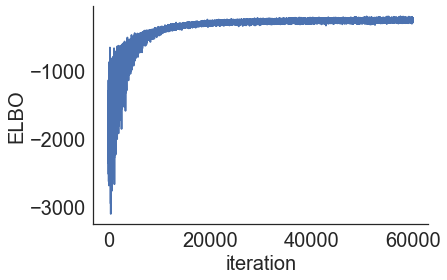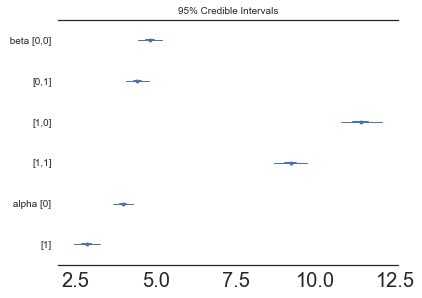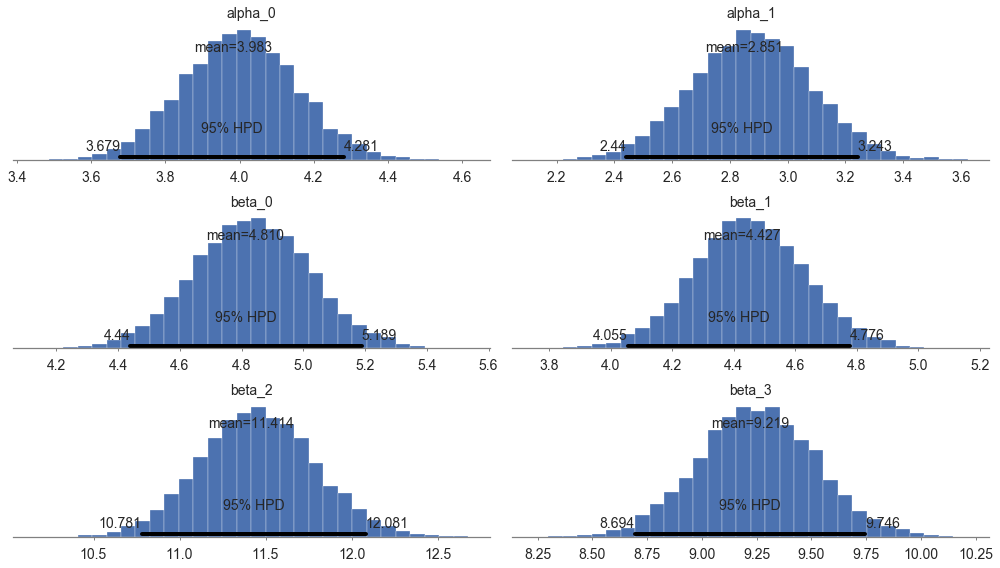Logistic Regression¶
Let’s set some setting for this Jupyter Notebook.
In [1]:
%matplotlib inline
from warnings import filterwarnings
filterwarnings("ignore")
import os
os.environ['MKL_THREADING_LAYER'] = 'GNU'
os.environ['THEANO_FLAGS'] = 'device=cpu'
import numpy as np
import pandas as pd
import pymc3 as pm
import seaborn as sns
import matplotlib.pyplot as plt
np.random.seed(12345)
rc = {'xtick.labelsize': 20, 'ytick.labelsize': 20, 'axes.labelsize': 20, 'font.size': 20,
'legend.fontsize': 12.0, 'axes.titlesize': 10, "figure.figsize": [12, 6]}
sns.set(rc = rc)
from IPython.core.interactiveshell import InteractiveShell
InteractiveShell.ast_node_interactivity = "all"
Now, let’s import the LogisticRegression model from the
pymc-learn package.
In [2]:
import pmlearn
from pmlearn.linear_model import LogisticRegression
print('Running on pymc-learn v{}'.format(pmlearn.__version__))
Running on pymc-learn v0.0.1.rc0
Step 1: Prepare the data¶
Generate synthetic data.
In [3]:
num_pred = 2
num_samples = 700000
num_categories = 2
In [4]:
alphas = 5 * np.random.randn(num_categories) + 5 # mu_alpha = sigma_alpha = 5
betas = 10 * np.random.randn(num_categories, num_pred) + 10 # mu_beta = sigma_beta = 10
In [5]:
alphas
Out[5]:
array([ 3.9764617 , 7.39471669])
In [6]:
betas
Out[6]:
array([[ 4.80561285, 4.44269696],
[ 29.65780573, 23.93405833]])
In [7]:
def numpy_invlogit(x):
return 1 / (1 + np.exp(-x))
In [8]:
x_a = np.random.randn(num_samples, num_pred)
y_a = np.random.binomial(1, numpy_invlogit(alphas[0] + np.sum(betas[0] * x_a, 1)))
x_b = np.random.randn(num_samples, num_pred)
y_b = np.random.binomial(1, numpy_invlogit(alphas[1] + np.sum(betas[1] * x_b, 1)))
X = np.concatenate([x_a, x_b])
y = np.concatenate([y_a, y_b])
cats = np.concatenate([
np.zeros(num_samples, dtype=np.int),
np.ones(num_samples, dtype=np.int)
])
In [9]:
from sklearn.model_selection import train_test_split
X_train, X_test, y_train, y_test, cats_train, cats_test = train_test_split(X, y, cats, test_size=0.3)
Step 2: Instantiate a model¶
In [10]:
model = LogisticRegression()
Step 3: Perform Inference¶
In [11]:
model.fit(X_train, y_train, cats_train, minibatch_size=2000, inference_args={'n': 60000})
Average Loss = 249.45: 100%|██████████| 60000/60000 [01:13<00:00, 814.48it/s]
Finished [100%]: Average Loss = 249.5
Out[11]:
LogisticRegression()
Step 4: Diagnose convergence¶
In [12]:
model.plot_elbo()

In [13]:
pm.traceplot(model.trace);

In [14]:
pm.traceplot(model.trace, lines = {"beta": betas,
"alpha": alphas},
varnames=["beta", "alpha"]);

In [15]:
pm.forestplot(model.trace, varnames=["beta", "alpha"]);

Step 5: Critize the model¶
In [16]:
pm.summary(model.trace)
Out[16]:
| mean | sd | mc_error | hpd_2.5 | hpd_97.5 | |
|---|---|---|---|---|---|
| alpha__0 | 3.982634 | 0.153671 | 0.001556 | 3.678890 | 4.280575 |
| alpha__1 | 2.850619 | 0.206359 | 0.001756 | 2.440148 | 3.242568 |
| beta__0_0 | 4.809822 | 0.189382 | 0.001727 | 4.439762 | 5.188622 |
| beta__0_1 | 4.427498 | 0.183183 | 0.001855 | 4.055033 | 4.776228 |
| beta__1_0 | 11.413951 | 0.333251 | 0.003194 | 10.781074 | 12.081359 |
| beta__1_1 | 9.218845 | 0.267730 | 0.002730 | 8.693964 | 9.745963 |
In [17]:
pm.plot_posterior(model.trace, figsize = [14, 8]);

In [18]:
# collect the results into a pandas dataframe to display
# "mp" stands for marginal posterior
pd.DataFrame({"Parameter": ["beta", "alpha"],
"Parameter-Learned (Mean Value)": [model.trace["beta"].mean(axis=0),
model.trace["alpha"].mean(axis=0)],
"True value": [betas, alphas]})
Out[18]:
| Parameter | Parameter-Learned (Mean Value) | True value | |
|---|---|---|---|
| 0 | beta | [[4.80982191646, 4.4274983607], [11.413950812,... | [[4.80561284943, 4.44269695653], [29.657805725... |
| 1 | alpha | [3.98263424275, 2.85061932727] | [3.97646170258, 7.39471669029] |
Step 6: Use the model for prediction¶
In [19]:
y_probs = model.predict_proba(X_test, cats_test)
100%|██████████| 2000/2000 [01:24<00:00, 23.62it/s]
In [20]:
y_predicted = model.predict(X_test, cats_test)
100%|██████████| 2000/2000 [01:21<00:00, 24.65it/s]
In [21]:
model.score(X_test, y_test, cats_test)
100%|██████████| 2000/2000 [01:23<00:00, 23.97it/s]
Out[21]:
0.9580642857142857
In [22]:
model.save('pickle_jar/logistic_model')
Use already trained model for prediction¶
In [23]:
model_new = LogisticRegression()
In [25]:
model_new.load('pickle_jar/logistic_model')
In [26]:
model_new.score(X_test, y_test, cats_test)
100%|██████████| 2000/2000 [01:23<00:00, 24.01it/s]
Out[26]:
0.9581952380952381
MCMC¶
In [ ]:
model2 = LogisticRegression()
model2.fit(X_train, y_train, cats_train, inference_type='nuts')
In [ ]:
pm.traceplot(model2.trace, lines = {"beta": betas,
"alpha": alphas},
varnames=["beta", "alpha"]);
In [ ]:
pm.gelman_rubin(model2.trace)
In [ ]:
pm.energyplot(model2.trace);
In [ ]:
pm.summary(model2.trace)
In [ ]:
pm.plot_posterior(model2.trace, figsize = [14, 8]);
In [ ]:
y_predict2 = model2.predict(X_test)
In [ ]:
model2.score(X_test, y_test)
In [ ]:
model2.save('pickle_jar/logistic_model2')
model2_new = LogisticRegression()
model2_new.load('pickle_jar/logistic_model2')
model2_new.score(X_test, y_test, cats_test)